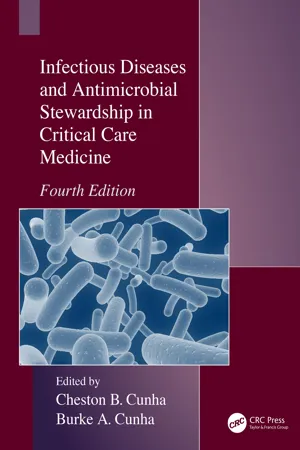
Infectious Diseases and Antimicrobial Stewardship in Critical Care Medicine
Cheston B. Cunha, Burke A. Cunha, Cheston B. Cunha, Burke A. Cunha
- 468 pagine
- English
- ePUB (disponibile sull'app)
- Disponibile su iOS e Android
Infectious Diseases and Antimicrobial Stewardship in Critical Care Medicine
Cheston B. Cunha, Burke A. Cunha, Cheston B. Cunha, Burke A. Cunha
Informazioni sul libro
Infectious Diseases and Antimicrobial Stewardship in Critical Care Medicine 4E has been fully updated and revised. The clinical diagnostic approach to common infectious disease problems in the CCU is the underlying theme in the book. Emphasized throughout is the importance of formulating an accurate early presumptive clinical syndromic diagnosis which is the basis for selecting optimal initial antimicrobial therapy in the CCU. Without an accurate presumptive clinical diagnosis, effective therapy is unlikely at best. Based on the most probable clinical diagnosis, optimal antibiotic empiric therapy, based on antimicrobial stewardship principles, minimizes resistance and antibiotic complications in the CCU.
This new edition features chapters that explain the tenets of differential diagnostic reasoning, differential diagnostic characteristics of fever patterns in the CCU. The proper interpretation of rapid diagnostic tests, in the appropriate clinical context, is included. The diagnostic importance of cardinal clinical findings, particularly when combined, in the appropriate clinical context is emphasized and remains the basis for clinical problem solving in the CCU. Uniquely, critical diagnostic physical findings in the CCU, including color atlas of diagnostic eye findings, are included as important diagnostic determinants in the CCU.
Written by infectious disease clinicians for CCU consultants, Infectious Diseases and Antimicrobial Stewardship in Critical Care Medicine 4E remains a useful evidence based and experience tempered key clinical resource for infectious disease problems in the CCU.
Key Features
- Essentials of the tenets of clinical diagnostic reasoning is explained as it relates to formulating a rapid and accurate clinical syndromic diagnosis in the CCU
- The diagnostic significance of fever patterns and their relationship to the pulse rate in the proper clinical context is explained in depth as related to the CCU setting
- Formulating an accurate early clinical syndromic diagnosis is presented as essential since it is the basis of effective empiric antibiotic therapy in the CCU
- How to combine key non-specific laboratory and imaging findings to increase diagnostic specificity and diagnostic probability in the CCU is presented
- Clinical perspective on the proper interpretation of the clinical significance of rapid diagnostic test results in the CCU is included
- A clinical approach to apparent "antibiotic failure" in the CCU is presented either due to actual antibiotic failure or seeming but unrelated non-antibiotic failure
- Section focuses on the practical aspects of antimicrobial stewardship particularly as related to optimizing dosing effectiveness while minimizing resistance and adverse effects in the CCU
Domande frequenti
Informazioni
Section II
Clinical Syndromic Approach in the Critical Care Unit
10 | The Clinical Approach to Sepsis and Its Mimics in the Critical Care UnitAbdullah Chahin and Steven M. Opal |
CLINICAL PERSPECTIVE
THE NEW SEPSIS DEFINITIONS
Definition Terms | 1991/2001 Versions 1/2 | 2016 (Version 3) |
|---|---|---|
Colonization | Not stated | Contact with a potential pathogen but no host response |
Infection | Contact with a pathogen inducing a local host immune response | Contact with a pathogen inducing a local host immune response |
Severe infection | Not stated | Contact with a pathogen inducing systemic host inflammatory response |
Sepsis | Infection accompanied by SIRS | Severe infection accompanied by one or more damaging host-induced organ dysfunction(s) |
Severe sepsis | Contact with a pathogen inducing SIRS and one or more damaging host-induced organ dysfunction(s) | Term no longer used, as all sepsis is considered severe and life-threatening |
Septic shock | Subset of severe sepsis with fluid-non-responsive hypotension necessitating vasopressors | Subset of sepsis with fluid-non-responsive hypotension necessitating vasopressors to maintain MAP >65 mmHg and blood lactate >2 mmol/L |
Condition | Features Mimicking Sepsis | Distinctive Features |
|---|---|---|
Macrophage activation syndrome | High fever, lymphadenopathy, altered mental status, cytokine elevation, pancytopenia, multi-organ failure | Pancytopenia on presentation, mucocutaneous findings (purpura, easy bruising, mucosal bleeding), hepatosplenomegaly, elevated ferritin |
Pancreatitis | Low grade fever, leukocytosis, tachycardia, lung infiltrates | Severe, epigastric pain, elevated amylase and lipase, abdominal computerized tomography findings consistent with pancreatitis |
Aspiration pneumonitis | Dyspnea, tachypnea, fever, lobar infiltrate on chest X-ray | Witnessed aspiration of gastric contents, pneumonitis comes on suddenly while pneumonia builds up gradual symptoms Infiltrates in dependent areas of lung |
Adrenal insufficiency | Fatigue, hypotension, hyperdynamic state with low SVR | Positive response to hydrocortisone stress dose |
Hypovolemia | Tachypnea, tachycardia, hypotension, low-grade fever | Clinical signs of dehydration External signs of volume loss (hemorrhage, trauma, vomiting, diarrhea) |
Pulmonary embolism | Fever, tachycardia, leukocytosis | Hypoxemia with respiratory alkalosis, unilateral leg swe... |